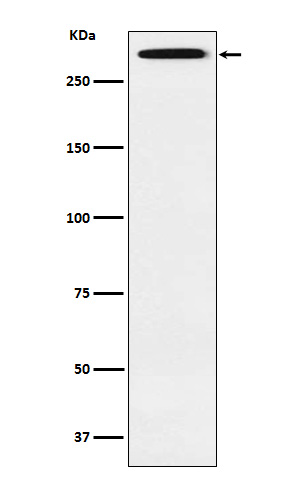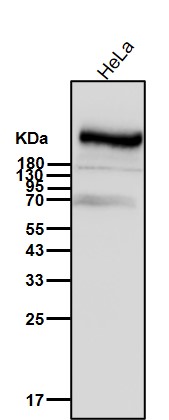

| WB | 1/1000-1/2000 | Human,Mouse,Rat |
| IF | 咨询技术 | Human,Mouse,Rat |
| IHC | 咨询技术 | Human,Mouse,Rat |
| ICC | 技术咨询 | Human,Mouse,Rat |
| FCM | 咨询技术 | Human,Mouse,Rat |
| Elisa | 咨询技术 | Human,Mouse,Rat |
| Aliases | 61E3.4; ATX; hSMG1; LIP; smg1;;SMG1 |
| WB Predicted band size | Calculated MW: 411 kDa ; Observed MW: 410 kDa |
| Host/Isotype | Rabbit IgG |
| Antibody Type | Primary antibody |
| Storage | Store at 4°C short term. Aliquot and store at -20°C long term. Avoid freeze/thaw cycles. |
| Species Reactivity | Human,Mouse,Rat |
| Immunogen | A synthesized peptide derived from human SMG1 |
| Formulation | Purified antibody in PBS with 0.05% sodium azide,0.05% BSA and 50% glycerol. |
+ +
以下是3篇与Smg1抗体相关的文献摘要简述:
1. **文献名称**:*"Smg1 heterozygosity exacerbates telomere shortening in mouse models of dyskeratosis congenita"*
**作者**:Kashima I, et al.
**摘要**:研究利用Smg1特异性抗体验证基因敲除小鼠模型中Smg1蛋白表达水平的变化,发现Smg1缺失会加速端粒缩短,并揭示其与端粒酶复合体功能异常的关联。
2. **文献名称**:*"SMG1 acts as a novel potential therapeutic target in triple-negative breast cancer"*
**作者**:Denning G, et al.
**摘要**:通过Smg1抗体进行免疫印迹分析,发现三阴性乳腺癌中Smg1蛋白高表达,并证实抑制Smg1激酶活性可增强化疗敏感性,提示其作为治疗靶点的潜力。
3. **文献名称**:*"The kinase SMG1 couples NMD activation to responses to environmental stress"*
**作者**:Yamashita A, et al.
**摘要**:利用Smg1抗体研究其在细胞应激反应中的作用,发现Smg1通过磷酸化UPF1调控无义介导的mRNA降解(NMD)通路,连接应激信号与RNA质量控制机制。
注:部分文献中Smg1抗体的应用可能隐含在实验方法中,上述摘要内容基于公开研究主题概括。实际文献需通过PubMed或学术数据库检索确认。
Smg1 (Suppressor with Morphogenetic effect on Genitalia 1) is a serine/threonine kinase belonging to the phosphatidylinositol 3-kinase-related kinase (PIKK) family. It plays a critical role in nonsense-mediated mRNA decay (NMD), a conserved surveillance mechanism that degrades aberrant transcripts harboring premature termination codons to prevent the production of truncated proteins. Smg1 phosphorylates UPF1. a central NMD factor, initiating downstream events that lead to mRNA degradation. Beyond NMD, Smg1 is implicated in maintaining genomic stability, regulating stress responses, and modulating DNA damage repair pathways. Dysregulation of Smg1 has been linked to cancer, neurodegenerative disorders, and immune dysfunctions, highlighting its broad physiological relevance.
Smg1-specific antibodies are essential tools for studying its expression, localization, and molecular interactions. These antibodies enable researchers to investigate Smg1’s role in NMD efficiency, cellular stress adaptation, and disease mechanisms through techniques like Western blotting, immunofluorescence, and immunoprecipitation. Commercial Smg1 antibodies are typically validated for specificity across human, mouse, and rat models, aiding translational research. Recent studies also explore Smg1 inhibitors as potential therapeutic agents, emphasizing the antibody’s utility in drug development. Understanding Smg1’s multifaceted functions continues to shed light on mRNA quality control and cellular homeostasis.
×